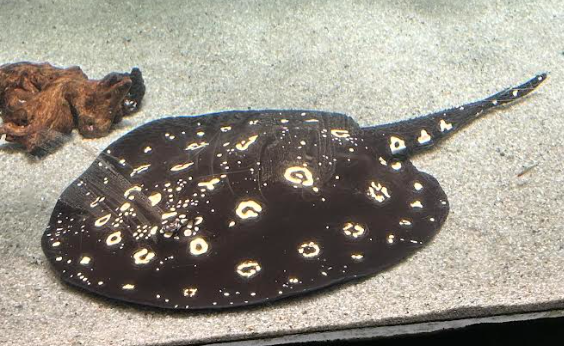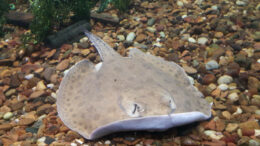Two little-known and rarely studied species of freshwater stingrays — yes, such a thing exists — just gained enhanced international protections, but will it be enough to save them?
That’s the debate echoing out of the latest meeting of the Convention on the International Trade of Endangered Species, which in November voted to protect two colorful species of Amazon stingrays: the Xingu River ray (Potamotrygon leopoldi) and the Rio Negro Hystrix ray (P. wallacei).
The move represents a rare victory for freshwater stingrays, who are relatives of sharks, says Patricia Charvet from Federal University of Ceará’s program on biodiversity conservation. She has spent decades advocating to protect these species.
“It’s a big challenge,” she says. “People only think about the sharks and rays that live in marine ecosystems, while freshwater species get ignored.”
While some, like Charvet, consider this a big victory, other experts expressed concerns that the situation for freshwater stingrays in the Amazon is more complicated, and that these new CITES listings leave other related species unprotected from the same threats.
Unstudied Species
Amazon stingrays live in most of South America’s river basins, not just the Amazon, and are the only group of sharks or rays adapted to live their entire lives in freshwater.
This sets them apart from species such as bull sharks, which can enter freshwater but spend most of their lives at sea.
“They’ve lost the ability to accumulate urea in their blood, which is the main strategy used by sharks and rays to keep their body fluids in equilibrium with seawater,” says Luis Lucifora of Argentina’s Instituto Nacional de Limnologia.
In other words, it’s not that they don’t enter the ocean. It’s that they can’t.

Another thing that sets them apart: They’re less well-known and less protected than their marine cousins.
But here’s what we do know: There are about 40 currently recognized species of these freshwater stingrays in four genera, although Charvet says there are some new species being described. The Rio Negro Hystrix ray, for example, did not receive scientific description until 2016. Meanwhile there are still ongoing taxonomic arguments over whether certain stingrays are different enough to count as separate species.
Regardless of how many species exist, researchers have observed some striking stingray behavior. Some specialize in prey that we don’t usually think of sharks and rays eating, like insects. They’re capable of some basic mathematical problem solving and may be the only species of shark or ray that engages in any kind of maternal care.
Just out!! Revision the the P. scobina complex and three new freshwater stingrays from the Amazon! https://t.co/NtHpQDlLUq pic.twitter.com/QrlAZOgNhV
— J P Fontenelle (@jpf_ishes) August 21, 2017
But the biological characteristic that has gotten these animals into conservation trouble is one not normally associated with threats to sharks and rays: Their spot patterns are absolutely beautiful. And that makes them very much in demand for the ornamental fish trade for home aquariums.
Every species has slightly different spot patterns, and hybrids, who can be bred in captivity, have all kinds of complex patterns. Some of these spots can even look like letters or numbers, which are requested by collectors with certain initials.
While these spot patterns from captive-bred hybrids are gorgeous, for a certain type of hardcore hobbyist it’s just not the same. “Some people color their dog pink, and it looks cool, but that’s not what a dog looks like, and some people want the real thing,” Charvet says.
That puts more pressure on wild populations, but at the same time it doesn’t stop determined collectors: She points out that one individual freshwater stingray with an especially rare pattern recently sold for $30,000.
The Ornamental Fish Trade
While habitat loss is the biggest conservation threat facing many freshwater fish, for some species it’s the aquarium trade, which involves thousands of species and is worth billions of dollars, that poses a big problem for some populations — especially those already threatened by habitat loss.
“Uncontrolled unregulated fisheries are never good, and there are examples of fishing endemic species at really high levels,” says Andrew Rhynne, a professor of marine biology at Roger Williams University. “By the time we realize that something is going on, it can be too late.”
Among hardcore aquarium hobbyists, trends can shift fast, resulting in rapid growth in demand. Eventually, captive breeding can reduce conservation issues associated with the aquarium trade, but until then the trade places too much pressure on wild specimens.
“When a species is newly discovered, a big market can develop for them immediately, before there’s a chance to perfect captive breeding,” says Michael Baltzer, executive director of SHOAL, a freshwater fish conservation organization. “This is a case for being cautious, because there’s often very little regulation on the trade in these species, and it can be very easy for people to collect fish and sell them all over the globe.”
Ironically, this trade exploits Brazilian workers when collectors in the country buy animals on the international market, after prices have been raised by a chain of middlemen. “Nowadays, Brazil imports some of the most expensive aquarium fish, even though they’re from Brazilian waters,” Charvet says. “We’re exporting today what our fishermen won’t be paid to catch tomorrow.”
Imperfect Protections?
All Amazon stingrays were previously listed under what’s known as CITES Appendix III. This gets less attention than Appendix I, which bans all international trade in a species, or II, which strictly regulates all international trade, requiring both import and export permits. Appendix III does not require an international vote at a CITES Conference of the Parties, and instead just requires a nation to declare that it’s adding an additional level of protection on this species found in its territory.
The new regulations elevated the two species — P. leopoldi and P. wallacei — to Appendix II. They also protected five “lookalike” species — those who are not as threatened as the target species but look similar enough to cause trouble at the level of customs import inspections and are therefore granted the same type of protections.
The Appendix II listing of some freshwater stingrays now means that more regulation and documentation is required to export or import these animals.

Many shark and ray species previously listed on CITES are threatened by overfishing that targets these animals due to people wanting to eat their meat and fins. The listing of Amazon freshwater stingrays is a little different, since they’re targeted for the live-animal trade, but the mechanisms are the same.
Not all experts interviewed for this piece were strongly supportive of the Appendix II CITES listing, with some noting that these species were already listed on Appendix III, which means that export permits from Brazil were already required.
“An Appendix III listing makes it just as illegal as Appendix II if you don’t have the paperwork,” Rhynne says. But he acknowledges that Appendix II, which requires an international vote, increases the profile of the species and the issues involved in their conservation. That can lead to more resources for enforcement.
And Charvet tells me that the Appendix III listing did not result in improved reporting or reduce illegal trade. Brazil enforced regulations associated with the Appendix III listing poorly, and illegal trade remained common. Rays were often smuggled over the border to Colombia and exported from there. She believes that stronger protections are necessary and has pushed for them at several CITES Conferences of the Parties prior to this year’s successful listing.
Spot these freshwater ocellate or peacock-eye stingrays (native to the rivers of S. America) in our Amazon flooded forest gallery. 👀 / 🎥TimW pic.twitter.com/oLnQmoLlx1
— California Academy of Sciences (@calacademy) May 25, 2017
For now, only the few species endemic to Brazil have gained these protections, leaving out their cousins in other South American river basins.
“The listing leaves out all the species from other countries,” Lucifora tells me. “If one keeps in mind the taxonomic problems that still affect South American freshwater stingrays, and the problem of international smuggling of species whose capture is illegal in one country to be exported from another country with less protections, then the most reasonable solution to me is to list the entire family, not just these species.” He points to requiem sharks, just protected by CITES at the family level.
And CITES listing doesn’t have an impact on problems of local conservation. Brazil and other nations still need stronger national laws to address habitat loss due to coastal development and dam construction, local consumption for meat, and targeting killings by locals who don’t want an animal that can give a painful sting living in their backyards.
If we fix these problems, experts say, ray populations may be healthy enough to withstand sustainable levels of harvesting for the aquarium trade.
“If we properly protect their habitat, a few collectors with dip nets probably won’t make a species go extinct,” Rhynne says.
The improved CITES regulation also doesn’t change the facts that not enough people are studying these species and current research on these threatened, ecologically important and evolutionarily unique animals is underfunded.
But this is still an important start. And after many years of trying to get freshwater stingrays listed on CITES, Charvet says seeing the proposal to protect them pass was “the best feeling in the world.”
She continues, “If I had to die tomorrow, I’d die happy because now I’ve done my part to help conservation.”
Get more from The Revelator. Subscribe to our newsletter, or follow us on Facebook and Twitter.
![]()


